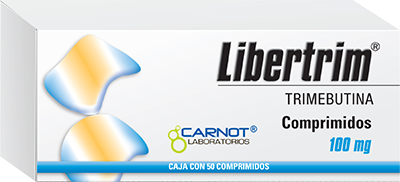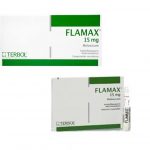Libertrim: Uses, How it works, Dosage, Side effects, Interactions

Libertrim is a Mexican brand of trimebutine, a drug with antimuscarinic and weak mu opioid agonist effects. It is used for the treatment of irritable bowel syndrome and other gastrointestinal disorders. Irritable bowel syndrome is a very common disorder and scientific tests show that about 10% to 15% of people in the United States have it. IBS is more common in women with almost twice as many women having it than men.
Libertrim is also useful for cases of colitis, esophagitis, functional colitis, and other conditions that affect gastrointestinal motility. It is commonly used for intestinal diseases and their symptoms, such as:
- Nervous colitis and irritable colon
- Abdominal pain and gas accumulation
- Regulate intestinal transit if constipation or diarrhea occurs
It is part of the Libertrim line, products dedicated to relieving symptoms caused by intestinal and gastroesophageal movements. Libertrim is also used to restart the movement of the gut after abdominal surgery and to prevent intestinal blockage (paralytic ileus).
How Libertrim works
Libertrim is a spasmolytic agent that acts directly on smooth muscle to modulate gastric motility. It shows a “dual function” that stimulates or inhibits spontaneous contractions depending on the concentration and prior contractile activity in the preparation. This medication slows down or speeds up the movement of the intestines if the gut is not working well.
Recently, trimebutine has also been shown to decrease reflexes induced by distension of the gut lumen and it may therefore modulate visceral sensitivity.

How To Use Libertrim
Take this medication by mouth before meals, usually 3 times daily or as directed by your doctor. The dosage of Libertrim is based on your medical condition and response to treatment. Do not increase the dose, take this medication more often, or continue taking it for longer than prescribed.
Use this medication regularly to get the most benefit from it. To help you remember, take it at the same time each day. It is important to take this medication exactly as prescribed by your doctor. If you miss a dose, take it as soon as possible and continue with your regular schedule. If it is almost time for your next dose, skip the missed dose and continue with your regular dosing schedule. Do not take a double dose to make up for a missed one. If you are not sure what to do after missing a dose, contact your doctor or pharmacist for advice.
Tell your doctor if your condition persists or worsens.
What are the side effects of Libertrim?
Libertrim can cause side effects. A side effect is an unwanted response to a medication when it is taken in normal doses. Side effects can be mild or severe, temporary or permanent. The Libertrim side effects listed below are not experienced by everyone who takes this medication. If you are concerned about side effects, discuss the risks and benefits of this medication with your doctor.
The following side effects have been reported by at least 1% of people taking Libertrim. Many of these side effects can be managed, and some may go away on their own over time.
Contact your doctor if you experience these side effects and they are severe or bothersome. Your pharmacist may be able to advise you on managing side effects.
• abdominal pain
• constipation
• diarrhea
• dizziness
• drowsiness
• dry mouth
• fatigue
• foul taste
• headaches
• hot or cold sensations
• indigestion
• nausea
• rash
Some people may experience side effects other than those listed. Check with your doctor if you notice any symptom that worries you while you are taking this medication.
What drugs can interact with Libertrim?
Your doctor or pharmacist may already be aware of any possible drug interactions and may be monitoring you for them. Do not start, stop, or change the dosage of any medicine before checking with your doctor or pharmacist first.
This drug should not be used with the following medications because very serious interactions may occur:
• pramlintide
If you are currently using any of these medications listed above, tell your doctor or pharmacist before starting Libertrim.
Before using this medication, tell your doctor or pharmacist of all prescription and nonprescription/herbal products you may use.
This document does not contain all possible interactions. Before using this product, tell your doctor or pharmacist of all the products you use. Keep a list of all your medications with you, and share the list with your doctor and pharmacist.





